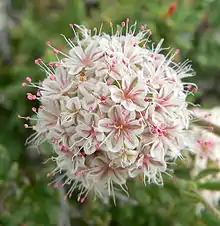Many plants that grow in the American West have use in traditional and herbal medicine.

Eriogonum fasciculatum, used in treatment of headaches and diarrhea.
List of medicinal plants
- Black sage, (Salvia mellifera), can be used against pain. A strong sun tea of the leaves and stems of the plant can be rubbed on the painful area or used to soak one's feet. The plant contains diterpenoids, such as aethiopinone and ursolic acid, that are pain relievers.[2]
- Broadleaf plantain (Plantago major) is one of the most abundant and widely distributed medicinal crops in the world. A poultice of the leaves can be applied to wounds, stings, and sores in order to facilitate healing and prevent infection. The active chemical constituents are aucubin (an anti-microbial agent), allantoin (which stimulates cellular growth and tissue regeneration), and mucilage (which reduces pain and discomfort). Plantain has astringent properties, and a tea made from the leaves can be ingested to treat diarrhea and soothe raw internal membranes.
- California bay (Umbellularia californica) leaves were used by the Tongva people to treat pain.[3]
- California poppy (Eschscholzia californica) was chewed by California Indians to treat toothache and to decrease milk production in nursing mothers anti-galactogogue.[4]
- Ephedra spp. is used as a diuretic, as a treatment for urinary tract infections, for asthma, and as stimulant due to the presence of ephedrine and other compounds. The sale of dietary supplements containing ephedra has been banned in the United States due to the risk of serious adverse events or death.[5]
- Horsetail or Scouring Rush (Equisetum spp.) is used as a diuretic because of it contains high concentrations of oxalic acid and calcium oxalate and therefore can also be a throat irritant if brewed improperly.[6]
- Matilija poppy, (Romneya coulteri) is applied topically to treat sunburn.[7]
- Willow Salix spp. used to treat headache and as an antipyretic due to the content of salicylic acid.[8]
- Yarrow (Achillea millefolium) is used for various ailments including cramps, fevers, and toothache.[9]
See also
References
- ↑ Schutz, K.; Carle, R.; Schieber, A. (2006). "Taraxacum—A review on its phytochemical and pharmacological profile". Journal of Ethnopharmacology. 107 (3): 313–323. doi:10.1016/j.jep.2006.07.021. PMID 16950583.
- ↑ "Palliative Care Among Chumash People". Wild Food Plants. Archived from the original (PDF) on 2007-10-06. Retrieved 2007-07-14.
- ↑ "Takape Kakaaka". Tongva Medicinal Plants. Retrieved 2007-07-14.
- ↑ Strike, Sandra (1994). "Aboriginal Uses of California's Indigenous Plants". Ethnobotany of the California Indians. Vol. 2. Champaign: Koeltz Scientific Books. ISBN 1-878762-51-6.
- ↑ Sales of Supplements Containing Ephedrine Alkaloids (Ephedra) Prohibited Archived 2007-02-10 at the Wayback Machine. From the U.S. Food and Drug Administration. Accessed September 12, 2007.
- ↑ Pérez Gutiérrez RM; Laguna GY; Walkowski A. (November–December 1985). "Diuretic activity of Mexican equisetum". J Ethnopharmacol. 14 (2–3): 269–272. doi:10.1016/0378-8741(85)90093-5. PMID 4094471.
- ↑ "Herbs and Spices". Commercial Vegetable Production Guides. Oregon State University. April 2, 2002. Archived from the original on July 6, 2007. Retrieved 2007-07-14.
- ↑ Mackowiak PA (October 2000). "Brief history of antipyretic therapy". Clin. Infect. Dis. 31 (Suppl 5): S154–S156. doi:10.1086/317510. PMID 11113017.
- ↑ "Yarrow". Factsheets. Purdue Center for New Crops. December 2, 1997. Retrieved 2007-07-14.
Further reading
There are several books about western medicinal plants:
- Moerman, Daniel E. (2000). Native American Ethnobotany. Timber Press, Portland. ISBN 0-88192-453-9. A comprehensive collection of many plants with descriptions of their uses.
- Strike, Sandra S. (1994). "Aboriginal uses of California's Indigenous Plants". Ethnobotany of the California Indians. Volume 2. Koeltz Scientific Books USA, Champaign. ISBN 1-878762-51-6. Very thorough discussion of California medicinal plants.
- George R. Mead (1972). The Ethnobotany of the California Indians: A Compendium of the Plants, Their Users, and Their Uses. University of Northern Colorado Press, Greeley. A partial list of plants used in the west.
- S. Foster & C. Hobbs (2002). The Peterson Field Guide Series A Field Guide to Western Medicinal Plants and Herbs. Houghton Mifflin Co, New York. ISBN 0-395-83807-X. A field guide with photographs of each plant and descriptions of their uses.
- C. Garcia & J.D. Adams (2005). Healing with Medicinal Plants of the West - Cultural and Scientific Basis for their Use. Abedus Press, La Crescenta. ISBN 0-9763091-0-6. Gives the Chumash Indian and scientific basis for use of many plants, along with color photographs of each plant. Cecilia Garcia is a Chumash healer.
- Lowell J. Bean and Katherine Siva Saubel (1972). Temalpakh: Cahuilla Indian Knowledge and Usage of Plants. Malki Museum Press, Morongo Indian Reservation. A discussion of Cahuilla Indian plants and their uses. Saubel is a Cahuilla Indian.
External links
This article is issued from Wikipedia. The text is licensed under Creative Commons - Attribution - Sharealike. Additional terms may apply for the media files.
